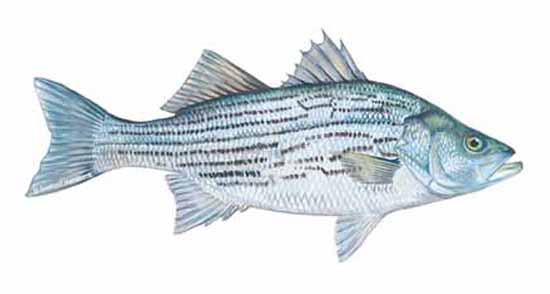Bass, Hybrid Striped
Published on
January 23, 2014

After the wild striped bass stocks nearly collapsed, the aquaculture industry responded by engineering this hybrid. The new species was established in 1967 by crossing the anadromous wild striper (Morone saxatilus) with white bass (M. chrysops), a fish that lives in both estuarine and fresh water. The result combines the attractive appearance and edibility of the wild striped bass with the hardier, faster-growing characteristic of the white bass. The hybrid also offers a greater yield than its wild parents. Farmed striped bass reach 5 pounds but are usually marketed at 1 to 3 pounds. The fish are grown in ponds, tanks and cages at more than 50 farms in the United States, but farms in the western region account for half the national production. Hybrid striped bass can be harvested, chilled, graded, sorted and shipped to market within 24 hours, ensuring freshness and quality. High production costs relegate hybrid striped bass to a niche market.
Morone chrysops x M. saxatilis
Bass
Sunshine bass, white bass, hybrid striped bass
Bar d’Amérique
Felsenbarsch
Persicospigola striata
Suzuki
Lubina Americana
After the wild striped bass stocks nearly collapsed, the aquaculture industry responded by engineering this hybrid. The new species was established in 1967 by crossing the anadromous wild striper (Morone saxatilus) with white bass (M. chrysops), a fish that lives in both estuarine and fresh water. The result combines the attractive appearance and edibility of the wild striped bass with the hardier, faster-growing characteristic of the white bass. The hybrid also offers a greater yield than its wild parents. Farmed striped bass reach 5 pounds but are usually marketed at 1 to 3 pounds. The fish are grown in ponds, tanks and cages at more than 50 farms in the United States, but farms in the western region account for half the national production. Hybrid striped bass can be harvested, chilled, graded, sorted and shipped to market within 24 hours, ensuring freshness and quality. High production costs relegate hybrid striped bass to a niche market.
Striped bass is a mild fish with a delicate, slightly sweet flavor that appeals to a wider range of consumers than traditional, wild-run striped bass, which has a more pronounced taste and a coarser texture. The raw meat is translucent white with a pinkish cast; it turns opaque white when cooked. It is moderately firm but flaky, and the oil content keeps it moist during cooking.Most hybrid striped bass are raised in oxygen-ated tanks or ponds, where strict control of water quality and feed ensures consistent flavor.
| Calories: | 97 |
| Fat Calories: | 21 |
| Total Fat: | 2.3 g |
| Saturated Fat: | 0.5 g |
| Cholesterol: | 80 mg |
| Sodium: | 69 mg |
| Protein: | 17.7 g |
| Omega 3: | 0.8 g |
Striped bass can be stuffed and baked whole (headed and gutted). When grilling the fish, leave the skin on. It has a delicate flavor and turns nice and crispy while the flesh remains moist.
Catfish, Black sea bass, Lake Victoria perch
- Bake
- Boil
- Broil
- Fry
- Grill
- Pate
- Poach
- Saute
- Smoke
- Steam
Live
Fresh: Whole, Dressed, H&G, Fillets
United States







